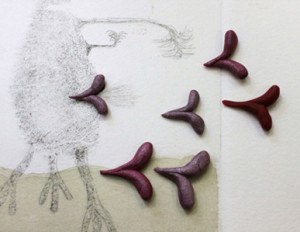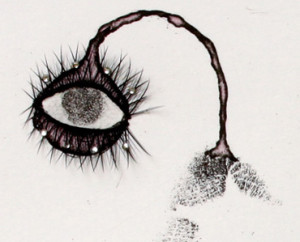My work is a quirky look at everyday things, combining familiar objects and material to transform the mundane into the wondrous. Though the work is often irreverent, I try to imbue it with formal elegance, humor, and physical sensuality to engage and beguile the viewer. I hope these physical manifestations charm and enchant you and erode your resistance to the unexpected.
I am interested how an everyday object can be transformed into an archetype. For most of my career I focused on installation and installational sculpture, starting with common objects like a typewriter, brick, shovel, luggage, or plastic bag. Though the last six years I have been focusing on etching and photo-etching, my conceptual practice hasn’t changed. All of the work starts with a found thing: wing carcass, doodle, fist print, license plate. Photo-etching has allowed me to process the bits of two-dimensional ephemera I’ve collected over the years.
How does naming change meaning? Does naming a shovel, The Shovel With Which We Buried Our Father, change how we see it? Is our experience of “shovel” now bound to our memories of our fathers? Has the shovel become an expression of filial devotion?
I use titles to play with these ideas and often I allow the titles to become verbose to draw attention to them. An old wing carcass can be both Something the Cats Dragged In and part of the fiction Flying Guiltboy’s Wing. In the Tripedal Wingless Leatherbird series, the images acquire long lists of descriptive attributes that become their whimsical names and play with the authority of taxonomic systems, as in the Green Crested Tripedal Wingless Leatherbird With a Warted Homunculus. I also relish the whimsy in the list of media and materials included for this work, like Sculpey® lips (toaster-oven baked craft clay) and store bought human hair eyelashes.
I find the rich physicality of the etched print very intriguing, as is the hyper-reality of a magnified photo-etching. As in my sculptural work, scale, specifically a work’s physical relationship to the viewer’s body, is important. Photo-etching allows me to enlarge scale and focus your attention on the otherwise unseen small. The wing used in Flying Guiltboy was only six inches long and the doodle that became Guiltboy was only one inch tall. The hyper-detail of photo-etching has surprised me with work that succeeds both intimately and at a distance, gesturally.
My newest work, the OHIO series, is based on an old license plate. I am enchanted by the ability of dots of ink to render the glare on a bit of reflective surface left on this rusty old thing. Lately the issue of thingness has been on my mind. Why am I not satisfied with a digital inkjet image, since all of the work must pass through that state to become a photo-etching? Because some sort of transmutation takes place with the interaction of light, copper, acid, ink, moisture and paper. It is alchemic and metaphoric. Image is transformed into thing. It is this rich physicality, this thingness, that makes it art.



